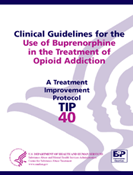

|
|
Home Physician Waiver Qualifications Buprenorphine Summits Nurses Guide to Buprenorphine Email Us |

Get the Latest on Substance Abuse and Mental Health Issues Did you know that you can receive updates on materials and resources related to substance abuse and mental health issues? By enrolling in SAMHSA’s eNetwork, a free service, you can stay current with the latest grant announcements, data, and publications that will help you serve your community. Once you Join the eNetwork, you can choose your areas of interest and receive the information that is important to you.  Buprenorphine: A Guide for Nurses
Buprenorphine: A Guide for Nurses
This guide, published in 2009, is part of the Technical Assistance Publication (TAP) Series. It is intended to provide nurses with current information about buprenorphine products—Suboxone® (buprenorphine and naloxone) and Subutex® (buprenorphine)—for the pharmacological treatment of opioid addiction. This guide can also serve as a resource to enable nurses working with physician prescribers to improve treatment outcomes for individuals receiving buprenorphine treatment for opioid addiction.  Medication-Assisted Treatment for Opioid Addiction in Opioid Treatment Programs Inservice Training
Medication-Assisted Treatment for Opioid Addiction in Opioid Treatment Programs Inservice Training
This 2008 publication provides training modules to assist program staff in discussing, understanding, and implementing the evidence-based practices described in Treatment Improvement Protocol (TIP) 43. All training materials are designed so that senior staff and clinical supervisors can easily lead the 45- to 60-minute sessions. Modules can be delivered as stand-alone training sessions or as elements within a large training program. There are 12 modules: Introduction and History; Pharmacology of Medications; Initial Screening, Admission Procedures, and Assessment Techniques; Clinical Pharmacotherapy; Patient-Treatment Matching; Phases of Treatment; Approaches to Comprehensive Care and Patient Retention; Drug Testing as a Tool; Associated Medical Problems; Treatment of Multiple Substance Use; Treatment of Co-occurring Disorders; and MAT during Pregnancy.Diversion and Abuse of Buprenorphine: A Brief Assessment of Emerging Indicators SAMHSA/CSAT commissioned an independent assessment in response to reports that availability of Suboxone® and Subutex® for the treatment of opioid addiction was accompanied by the emergence of a small but persistent problem with diversion and abuse of those medications. Assessment results suggest that buprenorphine diversion and abuse are concentrated in specific geographic areas. The phenomenon may reflect lack of access to addiction treatment, as some non-medical use appears to involve attempts to self-medicate with buprenorphine when formal treatment is not available. While the largest part of the diverted drug supply likely comes from buprenorphine prescribed by physicians—either for addiction or for pain—the presence of formulations that are not approved for use in the United States suggests that some is being illegally imported as well. This 2006 report summarizes the findings and conclusions resulting from the assessment, and lays out a series of recommendations for future action.2005 SAMHSA Evaluation of the Impact of the DATA Waiver Program Results from this legislatively mandated evaluation study detail how the Drug Addiction Treatment Act 2000 has expanded opioid assisted treatment. The study presents physician and patient survey results on treatment outcomes, patient characteristics, prescribing trends, barriers to treatment, and other useful information.  Treatment Improvement Protocol (TIP) 40
Treatment Improvement Protocol (TIP) 40
TIP 40, published in 2004, was the first clinical practice consensus guide produced by leading experts on the use of buprenorphine for the treatment of patients addicted or dependent on heroin or prescription pain medications, such as oxycodone, hydrocodone, or meperidine. The guidelines cover screening, assessment, and diagnosis of opioid dependence and its associated problems; assessment protocols for use in determining when buprenorphine is an appropriate treatment option; referrals to treatment professionals to provide the counseling and participation in self-help programs needed by most patients addicted to heroin or opioid prescription pain medications; detailed clinical protocols for use of buprenorphine in a variety of scenarios; and guidance on co-occurring pain, psychological disorders, or chemical dependency involving more than one substance.  Introducing Office-Based Treatment for Opioid Addiction
Introducing Office-Based Treatment for Opioid Addiction
This 2003 pamphlet was designed to provide patients and their families with important information about opioid addiction treatment with buprenorphine outside of the context of the traditional Opioid Treatment Program. The pamphlet provides an overview of buprenorphine and how it can be prescribed to treat addiction to opioids in the office-based setting. The brochure encourages patients to work with their health care provider to learn more about this treatment. |
 |
Home | Accessibility | Privacy | Disclaimer | SAMHSA
Department of Health & Human Services | USA.gov * Adobe™ PDF formatted files require the Adobe™ Reader to properly read them. Use this link to download this FREE program. |
 |